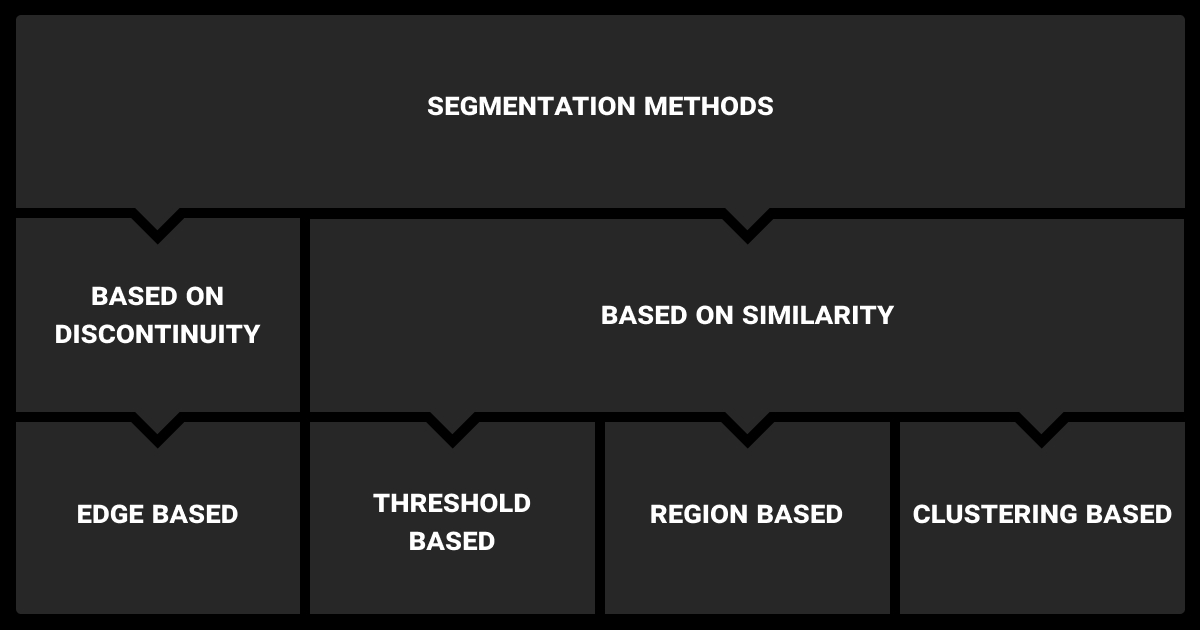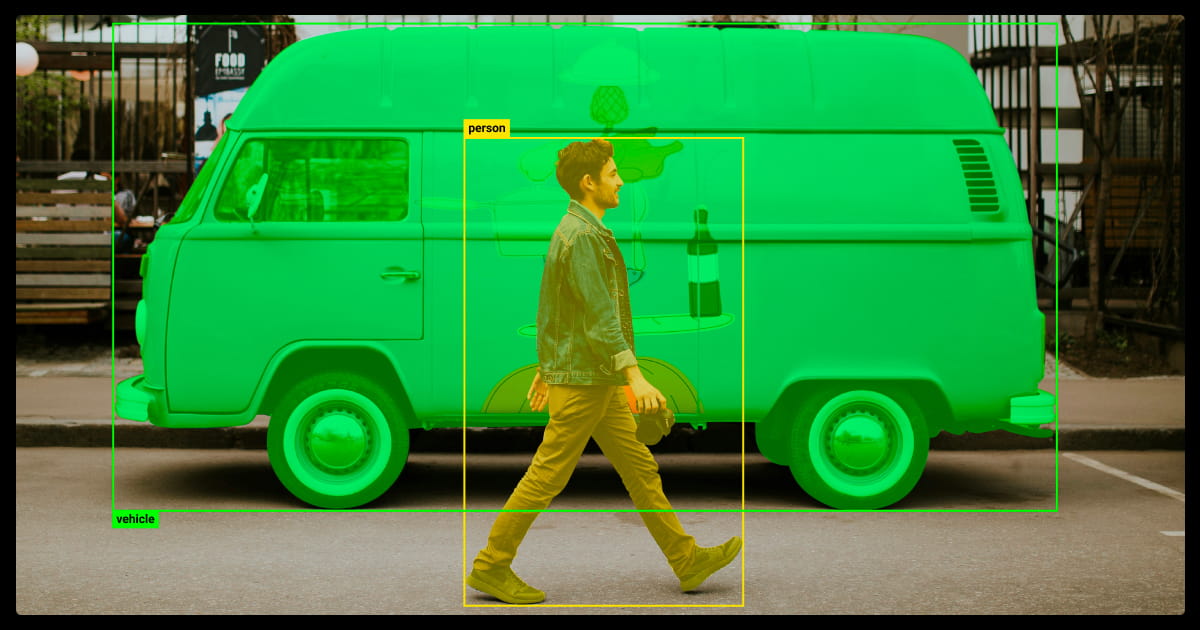Image Segmentation: Best Practices & Use Cases

TL;DR
- High-quality data preparation and precise annotation are crucial for accurate and effective image segmentation.
- There are 4 types of image segmentation: thresholding, region-based, edge-based, or clustering-based segmentation.
- Image segmentation is typically used in medical imaging, autonomous driving, remote sensing, retail, and document scanning.
What Is Image Segmentation?

Image segmentation, a key computer vision method, splits a digital image into separate pixel clusters known as image segments. It enhances object detection and similar tasks. By unraveling intricate visual details into tailored segment shapes, it accelerates image processing for practical use.
Understanding the best practices and practical applications of image segmentation in image processing techniques is essential for achieving high accuracy and efficiency.
Thorough data preparation is crucial for achieving successful image segmentation in image processing tasks. Ensuring that your dataset is both high-quality and well-balanced is crucial for building models that perform reliably across various real-world scenarios.
Data Quality
A diverse image segmentation dataset that includes various lighting conditions, scales, and object classes helps prevent overfitting, where models perform well on training data but fail on new data. Without this diversity, a model trained on a narrow dataset, like a single type of medical scan, may struggle with different types.
Class imbalance can bias models toward overrepresented classes. To counter this, techniques like data augmentation, oversampling, and synthetic data generation are used to balance the dataset, ensuring fair treatment of all classes and improving segmentation accuracy.
Data Annotation
Accurate image annotation is critical for successful image segmentation, as traditional machine learning models heavily rely on precise and consistent labeled data. Without a clear strategy on how to label data, the outcome can result in significant prediction errors, especially in high-stakes areas like medical image segmentation or satellite analysis.
Precision in Labeling
Careful attention to detail in labeling is essential. Accurate pixel-level labeling is particularly important in tasks where even small errors can lead to major misinterpretations, such as 3D image segmentation in tumor analysis or environmental monitoring.
Consistency & Review
Maintaining consistent labeling and regularly revising annotations based on model feedback are vital. This ongoing process gradually improves the model's accuracy over time.
Multi-Layer Annotations
For complex tasks like medical imaging, where different layers represent various tissue types or markers, multi-layer data annotation is often required. Depending on the task, using expert annotators for specialized areas can be effective, with strict guidelines ensuring annotation quality. The humans-in-the-loop approach helps to get the desired outcomes.
Top Image Segmentation Techniques

Effective image segmentation is the backbone of many machine learning applications, enabling precise object detection and analysis. Traditional methods, while less complex than deep learning approaches, are still powerful tools, especially in environments with limited computational resources.
Types of image segmentation encompass methods such as thresholding, region-based, edge-based, and clustering-based segmentation. Each type is selected based on the characteristics of the image and the specific segmentation objectives. For instance, thresholding is ideal for images with clear contrasts, while region-based segmentation is better for detecting contiguous regions with similar properties.
Thresholding Segmentation
Thresholding is a basic yet efficient technique for image segmentation. It converts a grayscale image into a binary image by classifying each pixel as either foreground or background based on its intensity relative to a set threshold. This method is ideal when there’s a clear distinction between objects and their background.
Global thresholding uses a single threshold value for the entire image, which is especially effective in environments with consistent lighting. For example, in OCR services, global thresholding is used to separate text from the background in scanned documents, simplifying text extraction.
Adaptive thresholding, in contrast, varies the threshold value across different regions of the image based on the local pixel intensity. This approach is beneficial in scenarios with uneven lighting or noise. In healthcare imaging, for instance, adaptive thresholding can accurately segment areas of interest, even when the image has inconsistent lighting, making it a valuable tool in complex diagnostic tasks.
Region-Based Segmentation
Region-based segmentation identifies areas of an image with similar characteristics like color, texture, or intensity, making it ideal for detecting contiguous regions.
Split and Merge Segmentation
This method divides an image into smaller regions, then merges adjacent regions that meet similarity criteria. It’s efficient for well-defined tasks, such as segmenting agricultural fields by crop type or health.
Graph-Based Segmentation
This method views the image as a graph, where pixels are considered nodes and edges denote similarity. It’s particularly effective in complex scenarios, like medical imaging, for delineating intricate structures such as blood vessels or tumors.
Edge-Based Segmentation
Edge-based segmentation detects object boundaries by identifying sudden changes in pixel intensity, which usually indicate edges.
Canny Edge detection is a highly accurate method for edge detection, especially useful in robotics and object tracking. It involves multiple stages, including noise reduction and edge tracing, to create precise edge maps. Sobel detects edges by calculating image intensity gradients, while Laplacian of Gaussian (LoG) combines Gaussian smoothing with the Laplacian operator to enhance edge detection. These techniques are widely used in industrial inspection to identify defects or anomalies.
Clustering-Based Segmentation
Clustering-based segmentation groups pixels into clusters based on feature similarity, which is particularly useful in applications like image compression and retrieval. By reducing image complexity while preserving essential information, clustering techniques help in efficiently processing large datasets. These methods are especially effective when dealing with images that can be segmented based on distinct features like color or texture.
K-Means Clustering is one of the most popular algorithms for this purpose, partitioning images into K clusters where each cluster represents a segment. It works well for tasks like segmenting satellite imagery into different land cover types based on color intensity. On the other hand, Mean Shift Clustering is a non-parametric technique that doesn’t require pre-setting the number of clusters. Instead, it identifies clusters based on local density, making it ideal for images with complex color distributions, such as natural scenes or remote sensing data.
Online Image Segmentation: Best Tools and Models
Image segmentation online enables real-time object detection and analysis using cloud-based AI. Recent advancements like Meta’s Segment Anything Model (SAM) and other transformer-based models are redefining how segmentation tasks are automated.
Top Image Segmentation Tools
| Tool/Model | Key Feature | Best For |
| Segment Anything (SAM) | Zero-shot segmentation on any object | General-purpose segmentation |
| SAM2 | Optimized version of SAM for real-time applications | Live segmentation workflows |
| DINOv2 (Meta AI) | Self-supervised vision model for robust segmentation | Object tracking, scene segmentation |
| Swin Transformer | Hierarchical transformer with shifted windows | High-accuracy image segmentation |
| MONAI | Deep learning toolkit for medical image segmentation | Healthcare applications |
| Label Your Data | Self-service annotation platform with API access & cost estimator | Customizable segmentation workflows |
| SuperAnnotate | Cloud-based annotation tool with AI-assisted labeling | Large-scale segmentation tasks |
| Roboflow | Web-based platform for training segmentation models | AI model development |
A data annotation platform plays a critical role in AI development, enabling efficient and scalable segmentation workflows for machine learning models.
Why Use Online Image Segmentation?
- Real-time Processing: Enables segmentation in live applications like autonomous driving and security surveillance.
- Scalability: Cloud-based solutions handle large datasets without local compute limits.
- Automation & AI Integration: Many tools offer pre-trained models to speed up development.
Use Cases
- Computer Vision: Label Your Data supports semantic, instance, and panoptic segmentation for training computer vision models.
- Medical Imaging: MONAI and SAM are widely used for segmenting tumors, organs, and microscopic structures.
- Autonomous Systems: Swin Transformer helps detect objects for self-driving vehicles.
- Retail & E-commerce: Online segmentation tools optimize product tagging and visual search.
Use Cases of Image Segmentation
By dividing images into meaningful segments, image segmentation enables precise analysis and decision-making, which is critical in fields ranging from healthcare to autonomous vehicles. Understanding how image segmentation is applied in different contexts highlights its value and demonstrates the breadth of its impact.
Image Segmentation in Medical Imaging
Image segmentation is integral to medical imaging, enabling the precise identification and analysis of anatomical structures. For example, in tumor detection, segmentation helps isolate tumors from surrounding healthy tissue, facilitating accurate diagnosis and tailored treatment planning.
According to this study, region-based segmentation techniques are often employed to distinguish between different tissue types, such as identifying organ boundaries in MRI scans or segmenting blood vessels in angiography. As the Massachusetts Institute of Technology states, beyond tumor detection, segmentation is also used in various other medical applications, such as brain imaging to differentiate between gray and white matter or in cardiology to segment the heart's chambers and arteries.
Image Segmentation in Autonomous Driving

In autonomous driving, image segmentation is critical for scene understanding and safe navigation. Edge-based and instance segmentation methods are commonly employed to identify and classify objects like pedestrians, vehicles, and road signs. For instance, Canny Edge Detection can identify lane boundaries on highways, ensuring that the autonomous vehicle remains within its designated lane. Accurate segmentation is essential for real-time decision-making, helping the vehicle’s AI to interpret its surroundings and react accordingly.
Additionally, instance segmentation plays a vital role in distinguishing between multiple objects in the vehicle's environment, such as differentiating between a pedestrian and a cyclist. This ability is essential for deploying advanced safety features like collision avoidance systems. By precisely segmenting and identifying various objects, autonomous vehicles can make better-informed decisions, minimizing the risk of accidents and enhancing overall road safety.
Image Segmentation in Remote Sensing and Satellite Imagery
In remote sensing, image segmentation is crucial for analyzing satellite imagery in applications like environmental monitoring, land use classification, and disaster management. Clustering techniques like K-Means effectively segment large-scale images into land cover types, such as forests, urban areas, and water bodies, enabling clear and actionable monitoring of environmental changes.
Moreover, remote sensing segmentation is essential in agriculture, where it helps monitor crop health and manage resources more effectively. By segmenting fields into different categories based on vegetation index or soil moisture levels, farmers can optimize irrigation, fertilization, and harvesting strategies. This image segmentation example illustrates how precision agriculture enhances crop yields while promoting more sustainable farming practices by minimizing waste and conserving resources.
Image Segmentation in Retail and E-commerce
In the retail and e-commerce sectors, image segmentation is utilized to enhance product categorization, inventory management, and customer experience. For instance, region-based segmentation can automatically categorize products in images by identifying key features such as color, shape, or texture. This process streamlines inventory tracking and ensures that product listings are accurate and visually consistent, which is critical for maintaining an organized and appealing online storefront.
Furthermore, semantic segmentation enables personalized recommendations by analyzing customer interactions with segmented product images. By understanding which product features attract customers, e-commerce platforms can suggest similar items, thereby increasing the likelihood of a purchase. This targeted marketing strategy not only boosts sales but also enhances the customer experience by making the shopping process more intuitive and tailored to individual preferences.
Image Segmentation in Document Scanning and OCR

Image segmentation is fundamental in document scanning and Optical Character Recognition (OCR) systems, where the primary goal is to efficiently extract text from scanned documents. Thresholding and edge-based segmentation techniques are commonly used to separate text from the background, improving the accuracy of OCR processes. For example, adaptive thresholding can handle variations in document lighting, ensuring that even faint or degraded text is correctly identified and converted into a digital format.
In addition to improving text extraction accuracy, segmentation also plays a crucial role in automating data entry and archiving historical documents. By accurately segmenting text, tables, and images within a document, OCR systems can streamline the digitization process, making large volumes of printed materials accessible and searchable. This capability is especially valuable in industries such as finance, legal, and education, where efficiently handling large volumes of paperwork is crucial.
About Label Your Data
If you choose to delegate data annotation, run a free data pilot with Label Your Data. Our outsourcing strategy has helped many companies scale their ML projects. Here’s why:
Check our performance based on a free trial
Pay per labeled object or per annotation hour
Working with every annotation tool, even your custom tools
Work with a data-certified vendor: PCI DSS Level 1, ISO:2700, GDPR, CCPA
FAQ
What is meant by image segmentation?
Image segmentation is the process of partitioning a digital image into distinct regions, isolating objects or areas of interest from the background. It simplifies complex image analysis for object detection or feature extraction.
What are the three types of image segmentation?
The three types of segmentation are semantic, instance, and panoptic. Semantic segmentation labels each pixel with a category, like "cat" or "dog." Instance segmentation spots each object separately, like two cats. Panoptic segmentation does both at once.
What is an example of segmentation in image processing?
An example is segmenting a tumor in an MRI scan, where the tumor region is isolated from surrounding tissue for detailed analysis. This enables precise measurement of its boundaries and characteristics for medical diagnosis and intervention.
What is image segmentation in CNN?
Image segmentation in CNNs (Convolutional Neural Networks) is the process that allows splitting the image into different regions, or zones, by assigning each pixel to a specific category. This technique allows identifying objects in detail and analyzing images by categorizing pixels based on their characteristics.
Which method is used for image segmentation?
One commonly used method for image segmentation is Thresholding Segmentation, which separates regions of an image based on pixel intensity levels, effectively distinguishing objects from the background. It is particularly useful in applications where the objects have a distinct contrast from their surroundings.
Written by
Karyna is the CEO of Label Your Data, a company specializing in data labeling solutions for machine learning projects. With a strong background in machine learning, she frequently collaborates with editors to share her expertise through articles, whitepapers, and presentations.

